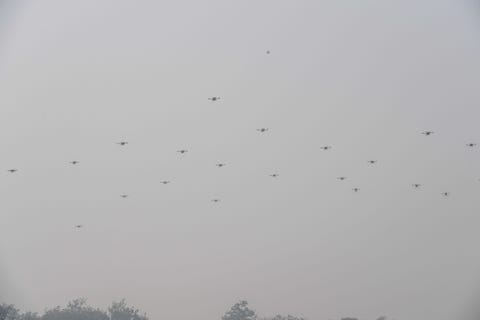KYLE MIZOKAMI
A new video released on YouTube has a dire warning for humanity: unless the nations of the world act now, the technology behind AI-powered drone swarms, what it calls “slaughterbots,” could wreak havoc on human society. The video’s creators, the Future of Life Institute, call on the United Nations to ban such robots before the technology gets out into the wild, where any group motivated enough to do so could use them to do violence.
The video, which has more than 2 million views as of December 8, imagines a world where autonomous weapons, equipped with artificial intelligence, carry out shocking attacks against civilians worldwide.
It’s easy to point out where real-life versions of the scenarios shown in the video have actually happened. In November 2020, Israeli intelligence assassinated Mohzen Fakhrizadeh, a major figure in Iran’s nuclear program, using a remote-controlled machine gun. The machine gun incorporated artificial intelligence to aim the gun, overcoming a 1.6 second lag time between an operator’s command and the camera feed to strike Fakhrizadeh’s motorcade. In 2021, the Israeli Defense Forces used drone swarms in an attempt to locate rocket launchers sited in Gaza and directed against Israeli population centers.

Members of an offensive swarm drone system fly drones to demonstrate skills during a ceremony to celebrate India’s 73rd Army Day in New Delhi on January 15, 2021.
PRAKASH SINGHGETTY IMAGES
In March 2020, a Turkish-made Kargu-2 drone conducted the first autonomous attack on human targets in history, attacking Libyan troops without permission from a human operator. In 2020, at the annual Association of the U.S. Army convention, Ghost Robotics showed off a rifle-armed quadruped drone.
As violent as it is, the video actually ends on a hopeful note. Two humans, on the verge of killing each other during wartime, are nearly killed by a third party—an autonomous drone—until it is later revealed the United Nations banned self-hunting weapons before the conflict. By cooperating against the common threat, the two save their own lives.
The surprise ending is tied to the real-life upcoming Sixth Review Conference of the Convention on Conventional Weapons, to be held at the United Nations in Geneva in mid-December. Organizations such as the Future of Life Institute, the creators of the video, as well as the International Committee of the Red Cross (ICRC), are urging conference attendees to recommend new rules limiting autonomous weapons, ones backed by legal teeth. “The ICRC recommends that States adopt new, legally binding rules on autonomous weapon systems to ensure that sufficient human control and judgement is retained in the use of force. It is the ICRC's view that this will require prohibiting certain types of autonomous weapon systems and strictly regulating all others.”
“Autonomous drone swarms represent one of the riskiest incarnations of autonomous weapons,” said Zachary Kallenborn, a weapons of mass destruction analyst with the Schar School of Policy and Government at George Mason University. “Perhaps only autonomous nuclear weapons are more terrifying. A ban on autonomous weapons would necessarily mean a ban on autonomous drone swarms.”
Autonomous weapons escaping into the wild may well be inevitable, but a ban or restrictions on their use could slow their spread until the nations of the world figure out how to deal with them.
“A treaty may also help slow the proliferation of more sophisticated drone swarms that cannot be readily built natively,” Kallenborn said. “States can create punishing laws, restrict access to needed technical equipment, collect and share intelligence information and warnings, protect high risk targets like world leaders and critical infrastructure, and dismantle terrorist organizations generally.”
Mankind hasn’t yet figured out how to deal with other weapons of mass destruction, such as chemical and nuclear weapons, a hundred years or more after their invention. Bans on the proliferation of such weapons, however, have at least limited their spread.
No comments:
Post a Comment